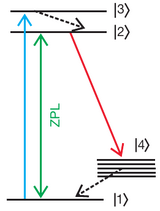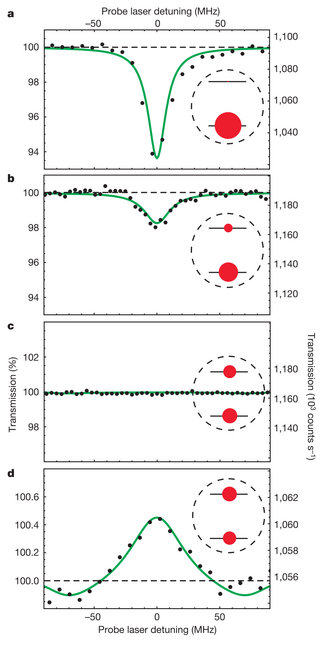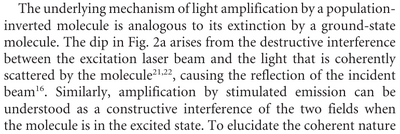A single-molecule optical transistor. J. Hwang, M. Pototschnig, R. Lettow, G. Zumofen, A. Renn, S. Götzinger and V. Sandoghdar in Nature 460:76 (2009). What the paper says!?

The so-called extinction mechanism—or interferences between the coherent fraction of an emitter and that of its driving field—is used to demonstrate a proof-of-principle single-molecule optical (light beams as signal) transistor (attenuate or amplify an incoming beam depending on the power of another [gating] beam). The gating beam controls the level of population inversion.

In the level scheme above of the single molecule, green is a weak CW laser, blue is the gating, a beam of varying power, red is the Stokes-shifted fluorescence to the vibronic excited states of the electronic ground state $\ket{4}$ and black is the coherence (off-diagonal) between levels 1 & 2. Although the system has a lot of structure, the quantum coherence is that of a two-level system.
This works in the Heitler regime:
Having established the coherent character of the amplification process, it is evident that a single-emitter transistor operates efficiently only in the unsaturated regime.
Even there, some features, such as different linewidth of the signal in different operations, appear to be shortcomings of the scheme, which can't get rid altogether of the strong intensity.
The transistor is demonstrated as follows: (a) with no pump, the CW beam is attenuated; (b-d) as the pump is increased, attenuation decreases until the molecule becomes transparent (c) or turns into gain (d):

These data demonstrate that a single molecule can indeed act as a transistor, in which the pulsed gate beam regulates the flow of the CW source beam by controlling the populations of the molecular ground and excited states.
The dip is produced by interference between the driving field and the coherent light from the molecule, as documented in earlier works.[1][2][3]
The underlying mechanism of light amplification by a population-inverted molecule is analogous to its extinction by a ground-state molecule.
In more details of the dip and gain mechanisms:

There is also a quantum-optical treatment of the mechanism in the last part of the paper.
References
- ↑ Interferometric Signatures of Single Molecules. T. Plakhotnik and V. Palm in Phys. Rev. Lett. 87:183602 (2001).
- ↑ Strong Extinction of a Laser Beam by a Single Molecule. I. Gerhardt, G. Wrigge, P. Bushev, G. Zumofen, M. Agio, R. Pfab and V. Sandoghdar in Phys. Rev. Lett. 98:033601 (2007).
- ↑ Efficient coupling of photons to a single molecule and the observation of its resonance fluorescence. G. Wrigge, I. Gerhardt, J. Hwang, G. Zumofen and V. Sandoghdar in Nature Phys. 4:60 (2008).